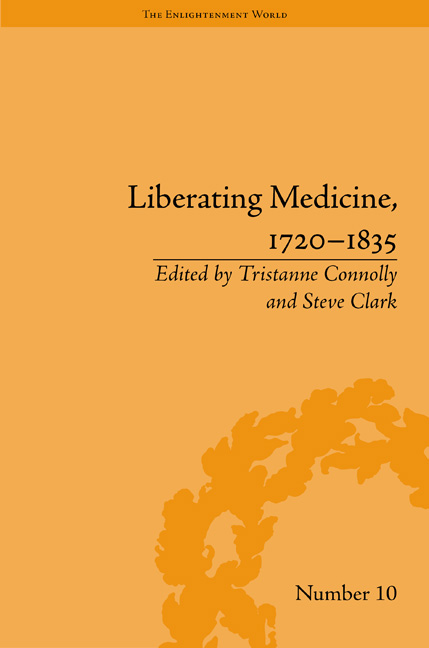Book contents
- Frontmatter
- CONTENTS
- Acknowledgements
- Contributors
- List of Figures
- Introduction
- I Spiritual Sickness and Hypochondria
- II Health and Emancipation
- III Madness
- IV Anatomized and Aestheticized Bodies
- 11 Authority and Imposture: William Godwin and the Animal Magnetists
- 12 George Stubbs's Dissection of the Horse and the Expressiveness of ‘Facsimiles’
- 13 In Submission: Frances Burney's Patient Narrative
- 14 The Surprising Success of Dr Armstrong: Love and Economy in the Eighteenth Century
- V Birth
- Notes
- Works Cited
- Index
11 - Authority and Imposture: William Godwin and the Animal Magnetists
from IV - Anatomized and Aestheticized Bodies
- Frontmatter
- CONTENTS
- Acknowledgements
- Contributors
- List of Figures
- Introduction
- I Spiritual Sickness and Hypochondria
- II Health and Emancipation
- III Madness
- IV Anatomized and Aestheticized Bodies
- 11 Authority and Imposture: William Godwin and the Animal Magnetists
- 12 George Stubbs's Dissection of the Horse and the Expressiveness of ‘Facsimiles’
- 13 In Submission: Frances Burney's Patient Narrative
- 14 The Surprising Success of Dr Armstrong: Love and Economy in the Eighteenth Century
- V Birth
- Notes
- Works Cited
- Index
Summary
Speaking of the state of the medical profession in 1823 in the preface to the first volume of the Lancet, the editor, Thomas Wakley, wrote:
We hope the age of ‘Mental Delusion’ has passed, and that mystery and concealment will no longer be encouraged. Indeed, we trust that mystery and ignorance will shortly be considered synonymous. Ceremonies and signs, have now lost their charms; hieroglyphics, and gilded serpents, their power to deceive.
In addition to other benefits, Wakley hoped that by reading the articles in the Lancet, ‘Man’ will be furnished ‘with a test by which he could detect and expose the impositions of ignorant practitioners’. The threat felt by the medical profession from impostors or ‘quacks’ was real enough, and Wakley went further in his efforts to dispel the mystery from professional knowledge in the journal's first issue by publishing the ingredients that made up such popular remedies as ‘Scot's Pills’ and ‘Daffy's Elixir’, thus revealing the ‘Compositions of Quack Medicines’.
In decades previous, though, while still in the age of ‘Mental Delusion’ Wakley describes, animal magnetism was one of the treatments that most outraged medical practitioners. So much so that in France Benjamin Franklin and others were ‘charged’ by the King Louis XVI to investigate and discredit animal magnetism, publishing their results in France in 1784, which were then translated into English by William Godwin in 1785. Animal magnetists, or mesmerists as they were also known after the German Anton Mesmer who performed these treatments most famously in Paris, argued that there was a magnetic fluid that flowed through the body until illness caused a blockage or obstacle to this flow. The magnetist believed that this obstacle could be removed by causing the patient to have convulsions or a ‘crisis’, which would restore the natural equilibrium. The practitioner could effect this crisis in a number of ways, using the magnets in their body to attract those in the patients’ bodies: by pressing a finger into the chest of the patient; by running their hands across the patient's body; by the patient touching something that had been magnetized; even by being pointed at from afar by the magnetist.
- Type
- Chapter
- Information
- Liberating Medicine, 1720–1835 , pp. 153 - 164Publisher: Pickering & ChattoFirst published in: 2014



